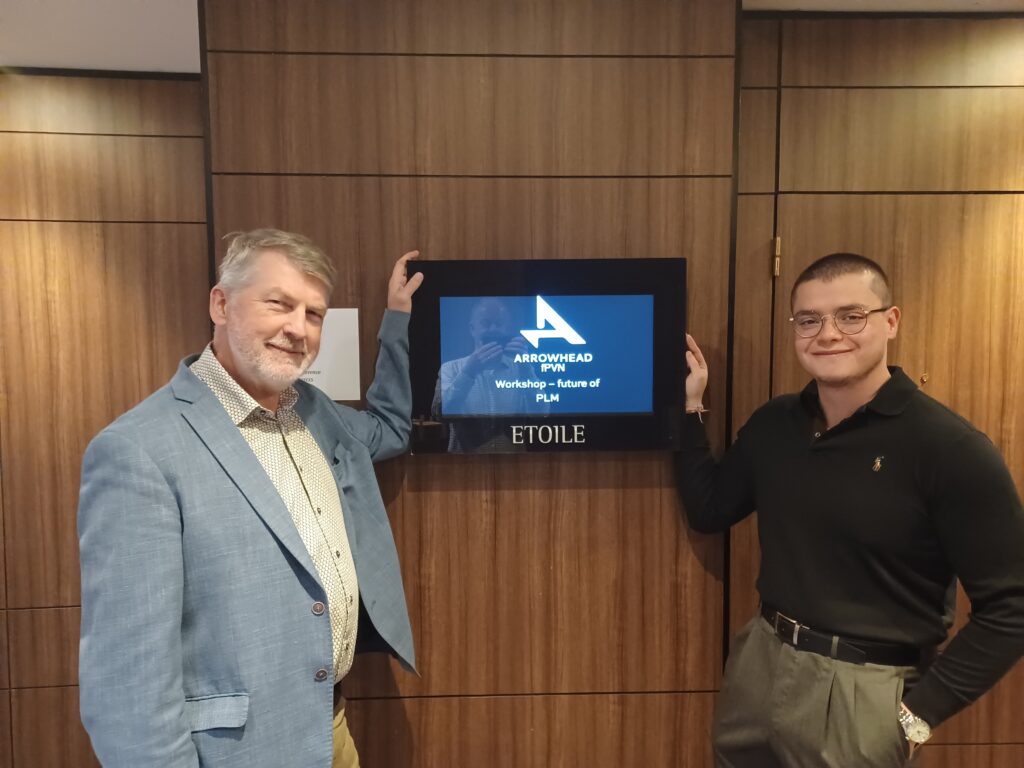Accelerating the Future of PLM & ALM (Insights from Workshop in Paris)

On November 4th, 2025, an expert meeting was held in Paris Jos Voskuil together with Håkan Kårdén, bringing together 32 professionals from academia, industry, and software development.
The event was sponsored by the Arrowhead fPVN project and focused on exploring the future of Product Lifecycle Management (PLM) and Asset Lifecycle Management (ALM), driven by the insights of four invited speakers.

The workshop was designed with two primary objectives:
1️⃣ Provide a shared space for presenting and discussing emerging concepts
The meeting enabled experts to exchange perspectives on lifecycle management, semantic technologies, engineering standards, and digital transformation. Feedback from the audience served as a valuable reference point for ongoing work.
2️⃣ Facilitate networking and collaboration across the community
Participants used the opportunity to connect during the workshop, at the PLM Roadmap/PDT Europe conference the following day, or through follow-up discussions initiated afterward.
The following sections summarize the speaker abstracts and provide links to the presentations.
1. Reasoning Machines: Semantic Integration in Cyber-Physical Environments
Torbjörn Holm & Jan van Deventer
👉 Presentation: W3C Major Standard Interoperability – Paris
This presentation examined the full lifecycle from requirements to operations and highlighted the role of knowledge graphs in connecting heterogeneous standards such as DEXPI, STEP (ISO 10303), CFIHOS, and the Arrowhead Framework.
Key topics included:
- Lifecycle phases and the significance of operation and maintenance as the longest and most dynamic stage.
- Categories of standards:
Modelling & representation, communication & integration, and architecture & security. - Semantic integration through OWL 2 DL, W3C alignment techniques, and the use of Arrowhead’s microservice-based approach.
- Development of multiple aligned knowledge graphs, including DEXPI KG, STEP KG, Arrowhead Framework KG, and work-in-progress CFIHOS ontology.
The presentation also described an architecture covering functional requirements, physical and digital twins, and semantically aligned knowledge-graph layers.
2. Beyond Handover: Building Lifecycle-Ready Semantic Interoperability
Jean-Charles Leclerc & Claude Fauconnet
Presentation: Beyond Handover – Building Lifecycle-Ready Semantic Interoperability
This contribution emphasized that industrial data standards must evolve beyond static handover documentation to support lifecycle semantics across long-lived assets.
Main points included:
- The need for dynamic semantic models capable of representing how technical objects evolve over time.
- Use of formal ontologies (BFO, IOF, IDO) to structure semantic knowledge graphs for robust interoperability.
- Introduction of the “pattern of change” as a way to connect data, processes, and knowledge throughout the lifecycle.
- Importance of governance, traceability, and shared modelling principles, in addition to technology.
- Examples from DEXPI, CFIHOS, and semantic alignment activities.
The presentation aligned closely with the first talk, reflecting common challenges and opportunities in Asset Lifecycle Management.
3. How can we achieve our vision of PLM – the Single Source of Truth?
Martin Eigner
Presentation: How can we achieve our vision of PLM – The Single Source of Truth?
This talk examined the long-standing ambition of Product Lifecycle Management to establish a consistent and authoritative Single Source of Truth (SSoT) across organizations.
Highlighted aspects included:
- Historical development of PLM and the difference between PLM and traditional PDM systems.
- Persistent fragmentation and legacy systems that hinder cross-lifecycle processes such as change management, configuration management, and quality management.
- The need for interdisciplinary thinking, model-based practices, new methodologies, and modern software technologies.
- Opportunities offered by extended digital threads, digital twins, and AI-enhanced lifecycle processes.
- Presentation of a “Lifecycle Hub” prototype illustrating the potential for integrated lifecycle data.
The session underscored the importance of governance, harmonized data models, and scalable architectures for achieving trustworthy PLM environments.
4. The Future is Data-Centric, Semantic, and Federated — Is your organization ready?
Yousef Hooshmand
Presentation: The Future is Data-Centric, Semantic and Federated
This contribution focused on the shift from application-centric transformation projects toward data-centric, semantic, and federated approaches.
Key insights included:
- Observations from major digital-transformation failures in several industries, emphasizing the risks of monolithic architectures and tool-driven strategies.
- The importance of treating data as a first-class asset and designing architectures “for change”.
- Structure and value of semantic data models composed of upper ontologies, integration layers, terminology models, and domain models.
- The role of federated ecosystems in enabling decentralized but coherent data usage.
- Principles such as user-centricity, iterative development, and technology-agnostic governance.
The presentation concluded that semantic business transformation is becoming an essential requirement for long-term competitiveness.
Relevance to Arrowhead fPVN
This workshop directly contributes to Arrowhead fPVN’s mission to:
✔ Develop interoperable, lifecycle-driven, federated digital ecosystems
✔ Enable semantic-ready, context-rich data exchange across domains
✔ Bridge engineering, operations, and service lifecycles
The insights shared during the workshop provide valuable input to ongoing work on architecture, interoperability, and semantic modelling within Arrowhead fPVN.
A Temporary Conclusion
A complete conclusion is still in progress and will be provided once ongoing synthesis work across the speakers is finalized.
Certain themes, however, emerged clearly during the workshop:
🔹 Data without context has limited value
Ontologies, semantic models, and domain-specific structuring methodologies are essential to modern lifecycle management.
🔹 Installing a graph database is not a sufficient solution
Value arises from governance, semantic alignment, and continuous lifecycle integration.
🔹 Standards remain necessary
Despite discussions about their pace, standards provide shared meaning and ensure interoperability.
🔹 AI depends on knowledge, not only data
Effective AI requires semantically enriched, lifecycle-aware information models.
Next Steps
A consolidated summary document will be shared with workshop participants as soon as the synthesis is completed.
The workshop contributed significant insights to the broader Arrowhead fPVN efforts on interoperable, semantic, and lifecycle-driven digital ecosystems.
Funding Acknowledgment
This workshop is funded by the Chips Joint Undertaking (Chips-JU) project Arrowhead fPVN (Grant No. 101111977) under the European Union’s framework for semiconductor innovation.

